Dr. Utr. Iur.
Frank
Van den Broeke
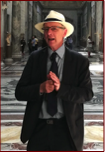
To book an authorised guided tour with me: .... Click here
Wine & Dine: ... Click here
Where to buy your tickets ... ? Click here
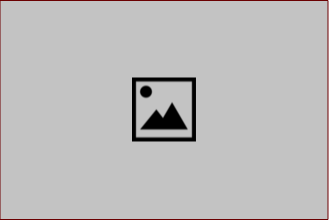
Almost daily I guide people in the Vatican Museums and the Sistine Chapel. Meanwhile they al know me .... the man with the panama-hat. But that’s not the only reason they know me. Daily, I am with my guests among the last visitors of the Sistine Chapel. Only just a few people are left before closing time. Entering the Chapel, I always tell my guests to find a seat at the door that connects the Sistine Chapel with the papal rooms behind. Michelangelo painted the chapel for the Pope, not for tourists. And there is a reason why you should do the same ....
The Sistine Chapel measures 40.93 meters (132 ft) by 13.41 meters (44ft) wide and 20.70 meters high (68ft) (threescore cubits by twenty by twentyfive cubits), and that is the precise dimensions given in the Bible for the temple of Solomon (1 Kings 6), which in turn was widely held to have been made in imitation of the shape of the universe ... where all the planets are turning around the sun. Now Michelangelo is transforming it in a celestial temple of Jerusalem.
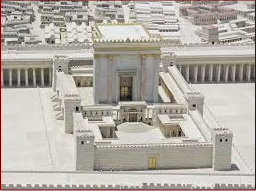
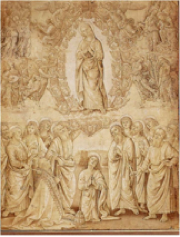
I asked myself what the pope would do, entering his private chapel, the so-called Cappella Magna. Vasari makes it clear for us: Paul III allegedly fell on his knees when he first saw it and exclaimed, “O Lord, charge me not with my sins when you come on the day of Judgment.” And of course, he would kneel on the porpxhyr stone at the door. The same would do Michelangelo for five long years while he was painting the last Judgement. What he would see in that moment is the non-existing picture of the Sistine Chapel. You would think that after 17 years of intense cleaning & restoration, the Vatican must have pictures from every point of view of the Chapel. I did an extensive research on google, going through thousands of images of the Sistine Chapel, I checked every book in the bookshop of the Vatican ... and it isn’t there. All the images of the Last Judgement are token in front of the Iconostasis - the rood screen or the Cancello, or from the balcony above the door. None, but absolutely none, is token from where the pope would kneel and what he would have seen in that position. But to understand it fully, we have to go back to what was painted there before by Perugino: The Assumption of the Virgin Mary. The Chapel was inaugurated on the 15 of August 1475, the day of the Assumption of the Virgin Mary. As you can see in the above pictures, also the work of Perugino had a division between an upper part and a lower one. And with purpose. If this is a vertical division between Heaven and Earth, there is also a horizontal division by the marble screen, the so-called rood screen or Cancello.
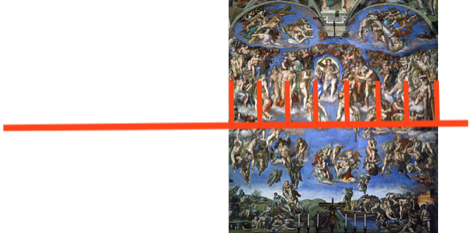
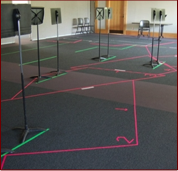
I believe, we all have seen on television parts of a service with the Pope. And you have to admit it: What a theatre !!!! Hundreds of figurines are playing their roles, without a dress rehearsal and nobody ever makes a mistake. How they are doing it !!? If you are going once on the stage of a theatre, you will notice that actors are putting little marks on the floor, so that they know exactly where to stand in order to reach the audience with a maximum of effect. That custom is not new ! The Catholic church is doing that already for centuries. The 15th century floor of the Sistine Chapel is a typical work of the Romanesque inlay work of marble and precious stones as originated by the brothers Cosmati, know as Opus Alexandrinum, which marks out the processional way from earth to Heaven. The first area is reserved for the laity with large whorls of inlays, the upper part reserved for the clergy beyond the Cancello with smaller islands of mosaics. The Cosmatic paving is a form integrated with all aspects of Christian culture and is run through with proportions and harmonies that echo the patterns and rhythms of the liturgy.
Unfortunately, later the Cancello was moved to increase the area reserved for the clergy. The colored marble is indicating the position where to stand during the procession and the celebration. By moving the Cancello, unfortunately, it is not crossing anymore in the centre of the choir balcony, neither the division that Michelangelo made in the Creation on the vault, and the division between the upper and lower part of the Last Judgement. As stated, the Cancello originally has cut the choir balcony in two. The psalms, sung from there were mostly responsorial psalms. The priest, who would stand in the upper part song the line representing the Word of the Lord, while the congregation in the lower part of the chapel would reply. The choir balcony evoked the dialogue between God and man, Heaven and Earth. And that is exactly what the Cancello is doing in relation with the works of Michelangelo: a dialogue between God and man. Bringing the rood screen back in its original position would point out in the vault the intervention of God in the upper part close to the altar, and how human mankind dealt with it in the lower part where the congregation was standing. Little by little, Michelangelo is making from the physical temple of Jerusalem a celestial Jerusalem. Even more so for the Last Judgement he frescoed at the altar. If you are kneeling (like the pope entering his Chapel and Michelangelo would have done for five years) on the porphyr stone at the entrance of the pope (today +/- 1,5 meter more inwards the chapel, due to the repositioning of the Cancello), you will notice that the top border of the rood screen crosses exactly the blue and the clouds of the Last Judgement where no figures are painted. (look at the red line in the pictures)
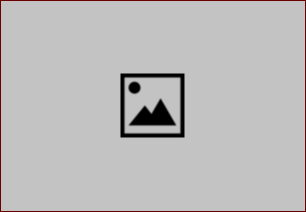
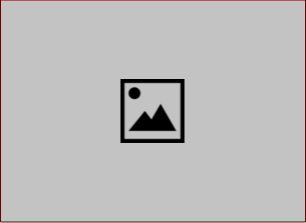
On top of the Cancello we have eight candles. The number eight in the bible has a very specific meaning: it represents a new beginning, meaning a new order or creation, and man's true 'born again' event when he is resurrected from the dead into eternal life. And indeed, above the cancello Michelangelo painted Heaven.
The number eight is also visible in the works by the most famous painters of the Renaissance in the lateral walls of the Sistine chapel. Perugino in the Handling of the keys to Saint Peter, painted in the background an octagonal church. In the foreground Peter is receiving the two keys: “I will give you the keys of the kingdom of Heaven: whatever you bind on earth will be bound in heaven; whatever you loose on earth will be loosed in heaven.” (Mt 16:19).
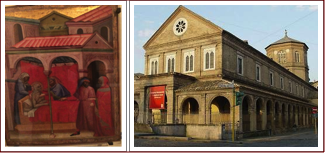
The number 8 in the Bible
Like the Old Testament Passover lamb, Jesus was selected as the Lamb to take away man's sins on the Hebrew day of Nisan 10 (April 1, 30 A.D. - John 12: 28 - 29). He was crucified on Nisan 14 (Wednesday, April 5 in 30 A.D.). His resurrection occurred, exactly as he stated, three days and three nights after he was buried, which was at the end of the weekly Sabbath day that fell on Nisan 17 (seventeen symbolizes victory). Nisan 17 was also the eighth day, counting inclusively, from the time Christ was selected as man's sacrificial Lamb. All this bears record of Jesus' perfect sacrifice and His complete victory over death.
Boys were to be circumcised on the 8th day. The number 8 symbolizes circumcision of the heart through Christ and the receiving of the Holy Spirit (Romans 2:28 - 29, Colossians 2:11 - 13). Those in Christ are becoming a new creation, with godly character being created by the power of God's Spirit (2Corinthians 5:17, Ephesians 2:10; 4:23 - 24).
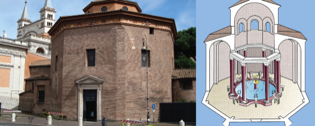
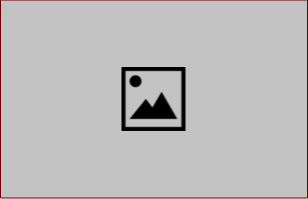
And it was Pope Sixtus IV who built the Sistine Chapel and also a chapel for the hospital Santo Spirito in Sassia, an octagonal building. By doing the works of mercy (visiting the ill), you will arrive in Heaven.
The octagonal tower is also the place where people through their baptism are initiating their way to heaven. The most famous is the one of the emperor Constantine near Saint John in Lateran. But that is just the beginning. Also Jesus’ final act on earth is taking place in an octagonal room: the Last Supper as painted by Roselli and Biagio d’Antonio in 1483-85 in the Sistine Chapel. What looks like an ordinary Banquet becomes a celestial banquet !!
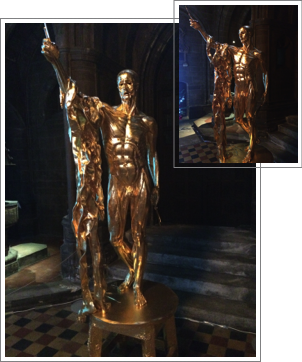
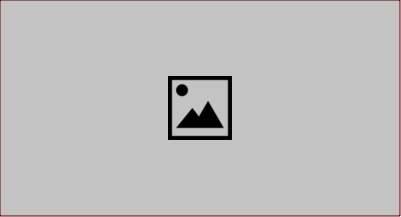
It was Dr. Vincenzo Pelosi of the Vatican who pointed it out to me. What looks like an ordinary banquet, is becoming a celestial banquet by the architectonical features of the room. It has an octagonal ceiling and even the table is octagonal. But it get even better. If you are kneeling on the porphyr stone at the entrance and looking at the last judgement, it looks like it is hidden behind prison bars ... even they are gilded. Being curious, I went to touch them, and surprisingly, they are made from wood. The whole chapel is made from the most expensive materials ... with exception of the Cancello. But it was on the wood (the cross or rood) that Christ redeemed us from the prison of the original sin. And indeed ! Those who are behind the left bars are the Aristotelian prisoners: they are just waking up after hearing the trumpets of the last Judgement, and are still prisoners of their bodies, waiting to be judged. Those who are depicted on the right hand side behind the bars are the platonic prisoners: Michelangelo depicted there those who are condemned to the purgatory, the waiting room for Heaven.
But the moment of the day that I like the most is at 5:35 pm. Then the custodians of the Sistine chapel are announcing the closing time of the Chapel. All those who are in the upper part of the Sistine Chapel are guided through the door in the middle of the Cancello towards the exit. That’s when the magic happens: the custodians are closing the door in the middle of the Cancello.
If you are in this precise moment at the kneeling point at the entrance door of the Sistine Chapel, two things of the Last Judgement are disappearing: Michelangelo depicted behind the closed door the angels who are announcing the Last Judgement and the deepest of the Hell behind the cross on the altar.
Isn’t it that the last Judgement is similar to a play in Broadway? After the last act, the curtain is coming down and the music stops playing. With the Last Judgement the divine ordeal falls over human mankind.It is over ! Those on the left and the right and behind the bars are prisoners who soon or later will be released. But if you are condemned to be in Hell behind the closed door, you will be forgotten by God and men for eternity.
Only one figure is crossing the blue field of the Last Judgement, the pending skin of Saint Bartholomew. There is a tradition that the Apostle was flayed alive. It is commonly accepted that it is a self-portrait of Michelangelo. By kneeling on the right spot, you will notice that his head is in heaven, but following the tradition of Saint Paul and saint Agostino, he is still prisoner in his body. I would like to finish this little article with one of the poetries of Michelangelo, written for the princess Vittoria Colonna in which he speaks about grace and human mortality.
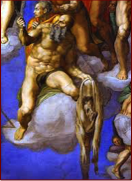

Exquisite Pain, The Martyrdom of Saint Bartholomew by Damien Hirst -(b. 1965)
Saint Bartholomew Church - London
Altar dorsal with The Works of Mercy, Olivuccio di Ciccarello, Ancona, 1388-1439
Santo Spirito in Sassia, hospital and Chapel
Anonymous Draughtsman, Copy of Perugino's lost Assumption of the Virgin on the altar wall of the Sistine Chapel, drawing, (Albertina, Wien)
Last Judgement Michelangelo
The red bar & lines represents the top of the Cancello and the 8 candles on top of it
The non-existing picture of the Sistine Chapel
On the left: Baptistery of the Basilica Saint John in Lateran
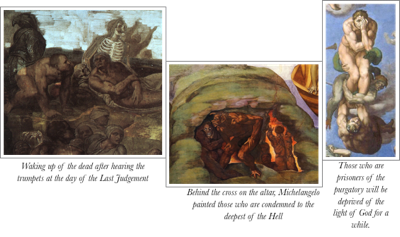
Above: The Last Supper
Rosselli & Biagio d'Antonio
Handling of the Keys
Perugino 1483-85
Sistine Chapel anno 1485
Riconstruction of the 2nd Temple of Jerusalem
E veggio ben com' erra, s' alcun crede
La grazia, che da voi divina piove,
Pareggi un' opra mia caduca e frale.
L' ingegnio e un' arte e la memoria cede :
C' un don celeste mai con mille pruove
Pagar puo sol del suo chi e mortale.
Yea, well I see what folly 'twere to think
That largess dropped from thee like dews from heaven
Could e'er be paid by work so frail as mine!
To nothingness my art and talent sink;
He fails who from his mortal stores hath given
A thousandfold to match one gift divine.